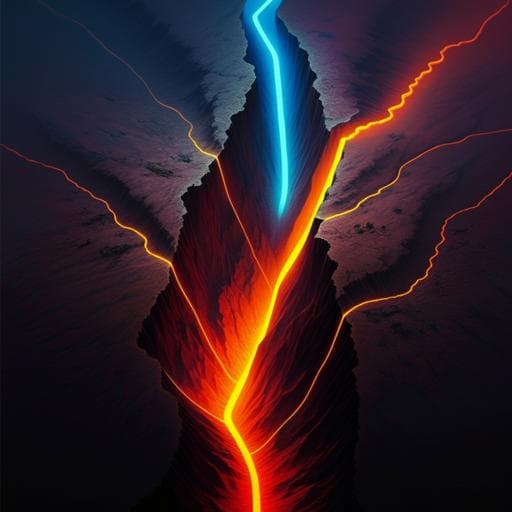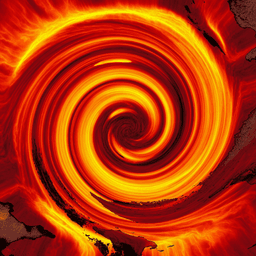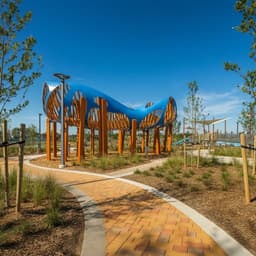
Earth Sciences
Nearby fault interaction within the double-vergence suture in eastern Taiwan during the 2022 Chihshang earthquake sequence
C. Tang, Y. N. Lin, et al.
This study, conducted by Chi-Hsien Tang and colleagues, uncovers the complex interactions between two significant faults in eastern Taiwan during the 2022 Chihshang earthquake sequence. With evidence of coseismic slip and dynamically triggered shallow slip, the research highlights a need for a time-dependent seismic hazard reassessment.
~3 min • Beginner • English
Introduction
The study investigates how nearby, head-to-head conjugate thrust faults interact within the Longitudinal Valley suture zone of eastern Taiwan, a key question for seismic hazard assessment. The 2022 Chihshang earthquake sequence—comprising a Mw 6.5 foreshock (Sept 17, 2022) and a Mw 7.0 mainshock (Sept 18, 2022)—provides a rare opportunity to observe interactions between the west-dipping Central Range fault (CRF) and the east-dipping Longitudinal Valley fault (LVF), which together accommodate a significant portion of the ~90 mm/yr plate convergence. Historically, the LVF has been active and partially creeping, while the CRF south of 23.5°N has been comparatively quiescent. This work aims to resolve coseismic and postseismic slip distributions on both faults, evaluate dynamic and static fault interactions (including Coulomb stress transfer), and place findings in the context of a century of seismicity and long-term moment budgets for both faults.
Literature Review
Prior work documents complex multifault interactions in thrust systems, including stepovers and detachment engagement (e.g., Iwate-Miyagi 2008, Kaikoura 2016). A head-to-head, conjugate thrust fault pair with documented interaction is the San Fernando and Oak Ridge faults in southern California, responsible for the 1971 Mw 7.1 and 1994 Mw 6.8 events, respectively, with long recurrence intervals and low slip rates complicating observation. In Taiwan’s Longitudinal Valley, the LVF is a primary plate boundary fault with several Mw 6.7–7.3 events over the past century, while the CRF’s activity has been debated, though a ~1908 Mw ~7 event north of 23.5°N is possible. Geodetic studies show the Longitudinal Valley absorbs ~30 mm/yr of convergence; the LVF shows interseismic creep and variable coupling, and the region exhibits high heat flow and possible lower-crustal ductile deformation. Historical records indicate alternating periods of seismic quiescence on the two faults, hinting at stress shadow effects. These studies frame the current analysis of the 2022 sequence, its dual-fault rupture, and inter-fault stress interactions.
Methodology
The authors integrate multiple datasets and modeling approaches:
- Field mapping: Rapid post-mainshock surveys of surface ruptures near Yuli and along the LVF identified left-lateral and reverse (west-side-up) offsets on the Yuli fault (attributed to the CRF), and minor fractures/shortening along the LVF. Bridge damage corroborated LVF surface offsets.
- Optical image correlation: Sentinel-2 L2A imagery (10 m bands B2–B4) spanning 2022-08-23 to 2022-09-22 was processed with COSI-Corr to retrieve N–S pixel offsets, with noise reduction and quad-tree resampling; validated by field offsets.
- InSAR: ALOS-2 PALSAR-2 L-band interferograms (ScanSAR desc. path 27 for foreshock; Stripmap asc. path 137 for mainshock) were processed with ISCE2 including ionospheric correction; unwrapping errors were corrected and validated against GNSS. Data were resampled, excluding ±1 km near fault traces.
- High-rate GNSS (HR-GNSS): 1 Hz PPP solutions (GipsyX/RTGx) were used to compute coseismic static offsets and to invert kinematic rupture. Atmospheric mapping and antenna calibrations were applied. Coseismic offsets were taken as differences around event times to avoid contamination by dynamic motion. Postseismic time series (34 days) were fit with a transient function capturing rapid decay.
- Static slip inversion: A dual-fault geometric model included a planar west-dipping CRF (60° dip, 0–20 km) and a listric east-dipping LVF (dip from 75° at surface to 45° at 20 km). Subfaults were ~2×2 km (492 patches CRF; 480 LVF). Joint inversion simultaneously used Sentinel-2 N–S offsets, InSAR LOS displacements, and GNSS coseismic offsets for the foreshock and mainshock. Non-negative least squares penalized dextral/normal components; Laplacian smoothing (λ1=0.5) and weak sum penalization (λ2=0.008) controlled roughness and suppressed poorly resolved subfault slip. Bilinear ramps accounted for InSAR orbital errors. Synthetic tests assessed CRF/LVF trade-offs and resolution.
- Kinematic rupture inversion: Joint inversion of HR-GNSS (0–50 s, low-pass 0.5 Hz) and GNSS static offsets using 3D spectral-element Green’s functions and parallel NNLS. Time windows: 24 windows of 0.8 s with 0.4 s overlap; maximum rupture speed 3.0 km/s; spatial/temporal smoothing and edge damping applied. Single- and dual-fault scenarios were tested.
- Early afterslip inversion: GNSS-only inversion for the first 34 days post-mainshock allowed slip to 30 km depth, primarily on CRF but including LVF; RMSE ~9 mm.
- Coulomb stress modeling: Stress changes computed using triangular dislocation kernels with shear modulus 30 GPa and ν=0.25; receiver rake 45°; effective friction 0.4. Sources included the 1951 LVF slip model and the 2022 foreshock/mainshock slip models.
- Moment budget estimation: For each fault, moment accumulation since 1900 was estimated as μ A s Δt using A=140 km×30 km, μ=30 GPa, and geologic slip rates (LVF 29.0–38.0 mm/yr; CRF 6.7–11.0 mm/yr). Moment release summed seismic moments of major events and aseismic moment from LVF shallow creep. Stress shadow effects were converted to equivalent moment reductions using τ=K sc (K=2–18 MPa/m) and Aμsc.
Key Findings
- Dual-fault rupture and slip distribution:
- Foreshock (Mw 6.4–6.6): Slip confined to the CRF; rupture propagated southwards and terminated at ~5 km depth. Seismic moment 5.7–9.7 ×10^18 N·m.
- Mainshock (Mw 7.0): Two major CRF asperities (5–15 km depth north of epicenter; deeper patch extending to surface north of Yuli). Peak slip ~2.4 m; average rake ~53°. Seismic moment 3.3–3.6 ×10^19 N·m.
- LVF experienced predominantly shallow (<5 km) left-lateral slip near Chihshang during the mainshock, with additional shallow slip near Yuli (bridge damage). LVF moment 3.2–4.9 ×10^18 N·m, ~9–15% of total mainshock moment.
- Dynamic triggering on LVF:
- LVF moment release began ~2–3 s after CRF onset and persisted up to ~20–26 s, consistent with dynamic triggering by strong S or Rayleigh waves. Later-phase increase (15–20 s) likely associated with waves from the second CRF asperity.
- GNSS and InSAR displacements:
- Mainshock produced up to ~0.95 m uplift and ~0.65–0.72 m horizontal motion with asymmetric LOS patterns across the CRF. Nearby GNSS stations across the LVF (TAPE–TAPO, ~570 m apart) showed opposite motions, indicating near-field LVF shallow slip.
- Postseismic slip behavior:
- Limited to no shallow afterslip on up-dip CRF despite shallow coseismic slip deficits (potentially due to sparse stations). Significant deep afterslip (~0.8 m) down to ~30 km on CRF in aseismic zone beneath SE Central Range, suggesting viscoelastic flow contributions.
- LVF exhibited shallow afterslip near Chihshang despite an estimated Coulomb stress drop of ~1 MPa, implying a frictionally transitional, conditionally stable shallow LVF capable of interseismic creep, coseismic and postseismic slip.
- Coulomb stress transfer:
- Foreshock CRF slip increased Coulomb stress by ~0.5 MPa at the northern edge, correlating with aftershocks and eventual mainshock nucleation.
- Mainshock caused a ring of increased Coulomb stress (up to ~2 MPa) around CRF slip patch and a continuous stress decrease on LVF (~0.5–1 MPa decrease; max ~1 MPa near hypocenter), implying temporary impediment of LVF seismic potential.
- 1951 LVF ruptures likely decreased stress on CRF by ~1–2 MPa, consistent with subsequent CRF quiescence.
- Historical out-of-phase seismicity and quiescence:
- After major events, the conjugate fault experienced quiescence: ~37 years on LVF after 1908 CRF event; ~62 years on CRF after 1951 LVF sequence. Larger moment release on one fault associated with longer quiescence on the other.
- Over ~120 years, CRF and LVF moment releases trend out of phase, consistent with a stress shadow mechanism.
- Moment budgets and future hazard:
- CRF: The 2022 sequence largely released the moment accumulated since 1908; current budget ~−0.7 to 5.9 ×10^19 N·m (surplus potentially addressed by smaller events, postseismic transients, and future events filling spatial gaps, notably north of 23.75°N).
- LVF: Significant surplus accumulation since 1951; current surplus 1.7–3.1 ×10^20 N·m, equivalent to Mw ~7.4–7.6. Given accumulation trends, another series of major LVF earthquakes comparable to 1951 is plausible within ~45–84 years.
- Structural relations:
- Up-dip CRF likely submerges beneath LVF south of Chihshang; geometry influences observed displacement discontinuities and interactions.
Discussion
The observations demonstrate strong, geometry-dependent interactions between the CRF and LVF during the 2022 Chihshang sequence. Coseismic CRF slip dynamically triggered shallow LVF slip with a short delay, while static stress changes from the mainshock reduced Coulomb stress on the LVF, implying a transient reduction in LVF seismic potential. Conversely, historical LVF ruptures (1951) reduced stress on the CRF, consistent with prolonged CRF quiescence. The shallow LVF, despite interseismic creep and a post-mainshock Coulomb stress decrease, accommodated additional coseismic and postseismic slip, indicating a frictional transition zone susceptible to dynamic triggering and time-dependent slip. The out-of-phase moment release pattern and alternating quiescence suggest stress shadowing modulates seismicity between the conjugate faults. These dynamics necessitate time-dependent seismic hazard assessments that explicitly incorporate dual-fault interactions, geometry (including possible fault overlap and blind up-dip terminations), and viscoelastic lower-crustal contributions to postseismic deformation. The findings also inform comparisons to other conjugate systems (e.g., Los Angeles basin), where lower slip rates may yield even longer quiescent intervals following large events.
Conclusion
This study establishes that the Central Range fault and Longitudinal Valley fault form an active head-to-head, conjugate thrust system that can rupture jointly during major earthquakes. The 2022 Chihshang sequence featured dominant CRF slip with dynamically triggered shallow LVF slip, significant static stress interactions (mutual stress suppression), and a continuation of out-of-phase seismic moment release evident in historical records. Moment budget analysis indicates that CRF has largely expended its accumulated moment since 1908, while LVF has accumulated a substantial surplus equivalent to Mw ~7.4–7.6, suggesting the likelihood of another major LVF sequence within decades if current trends persist. The results call for time-dependent, physics-based seismic hazard assessments that incorporate realistic geometry, dual-fault slip behaviors, dynamic and static interactions, and viscoelastic effects. Future work should improve geometric and coupling models (including offshore geodesy), investigate the shallow LVF’s frictional properties via laboratory experiments and numerical simulations, and develop models to test the stochastics and stationarity of the observed out-of-phase pattern.
Limitations
- Geodetic coverage limitations: Sparse GNSS north of Chihshang near the CRF may mask shallow afterslip; short baselines across the Longitudinal Valley limit depth resolution and discrimination between single vs. dual faults and fault intersections.
- InSAR issues: Low coherence in mountainous areas and unwrapping errors (partly corrected) introduce uncertainties; some data tracks affected by ionospheric disturbance.
- Fault geometry uncertainties: CRF geometry, especially up-dip terminations and overlap beneath LVF, is only partially constrained; assumptions include planar CRF with 60° dip and listric LVF.
- Stress modeling simplifications: Effective friction fixed at 0.4; receiver rake set to 45°; 1951 stress changes not fully corrected for postseismic effects; Coulomb calculations neglect interactions among adjacent subfaults and 3D rheology.
- Postseismic interpretation: Aftershock scarcity and deep afterslip suggest viscoelastic flow; inverted afterslip may partly proxy viscoelastic deformation, not purely fault creep.
- Moment budget approximations: Use of uniform fault areas (140×30 km), constant shear modulus, and geologic slip rate ranges; smaller events (Mw<6) and aseismic processes may not be fully accounted for.
Related Publications
Explore these studies to deepen your understanding of the subject.







